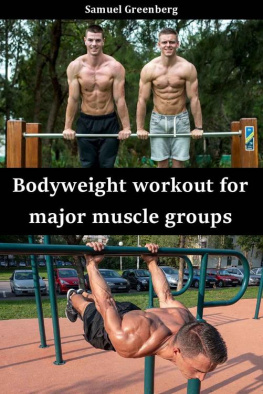The last thing before getting started will be mentioning that the workout program you are about to be mastering and the information that strongly ties to it have all been perfected in a personal trainer-client relationship environment, and the intensity of the workouts was adapted based on the joint and muscle capacities of each individual client.
For that matter, since you will be going unsupervised, we highly suggest paying additional attention to what your ligaments and muscles can handle in the beginning.
If an exercise is too difficult to complete in 4 sets and 12 repetitions, do as many repetitions as you can handle. That is more than sufficient to cause the tissue rupture required for muscle growth, while injury will only result in a delay in workouts and long-term results.
Now, to start our journey with the most important things to know when training, what are we really chasing? Muscle growth, as weight loss comes with it in this system. And how do we achieve muscle growth?
How do we grow our muscles?
The simple answer people give is training, but that is insufficient for us to completely understand the muscle building process
At birth, our bodies have a certain amount of muscle fibers, all of them making up certain muscles, combined with ligaments creating the muscular system. Through the contraction and relaxation of your muscles, movement is achieved, when the brain signals the neuro-transmitters in your body to do a certain movement.

As we grow and develop, so do our muscles, becoming bigger and stronger, in order to support and motorize a bigger and heavier body. Usually this process continues until the muscles are strong enough to support our full-grown bodies, depending on the lifestyle were living, the process may result in a thicker musculature in athletic individuals on specific parts of the body, and thinner muscles for the individuals who did not show signs of high physical activity during their growth period. The muscles were left with naturally are not the limit however, not by a longshot, as mother-nature created us to be the most advanced living mechanisms, like other species, we also have the instinct of adaptation. Like our ancestors bodies started to shed body-hair as the climate was warming up and adaptation was required to keep the body cool, the modern human can adapt to new situations just as well as his ancestors.
At the core of muscle growth stands the concept of adaptation, as our body is facing new challenges, such as lifting a weight thats too heavy, the ancient instinct of adaptation powers up and receives the message We need to lift this but we are not strong enough, we need to adapt to heavier weights. and the muscle gaining process is let loose. This description is very primitive, as the process is a lot more complex, and we will get into details soon. After the need for adaptation is established, we need to provide stimulus in order to make the muscles grow, which is training. By constantly facing our bodies with new challenges, each time harder, the need for adaptation becomes a solid routine and the systems required to achieve muscle growth are given continuous work. If youve ever heard that consistency is the base of any fitness routine, now you know why, as the continuous stimulus is necessary to keep the body fired up and ready to develop.
Not all stimulus was created equal, and simply living, as in doing an everyday routine and activity will get your body to adapt only as much as needed, which has most likely been achieved by now, and the lack of further stimulus will have your body breaking down the muscle you already have, in order to reduce the amount of energy needed maintaining them, without actually using the power they generate for anything. The stimulus provided has to be hard enough to engage the muscle to a point where it can no longer complete the task, such as lifting the same weight 20 times, most likely for the 20 th repetition your muscles will have exhausted.
When our muscles are exposed to sufficient stress, through the engagement in activities that are too difficult for our muscles to complete, such as lifting a 15 kg dumbbell using your bicep, the muscle gets damaged, with microscopic ruptures in the muscle fiber.

Believe it or not, this is exactly what bodybuilders train for, to damage their muscle fibers. It may sound counter intuitive how people interested in growing their muscles, are actually doing so with an activity that damages them. Science backs up their actions, as the damaging of the muscle fibers triggers a reaction through which cytokines, small molecules that help with muscle growth, which engage the immune system to repair the damaged fibers.

It is this very process that stimulates muscle growth, as the body is aware of the need for adaptation, the damaged muscle fibers are not only getting repaired, but this time, the body, if provided with the required materials, rebuilds the fibers bigger and stronger, eventually thickening the muscle.

The bodybuilding community has been asking if there is a way to actually build more muscle fibers, which science quickly answered by saying no, the amount of muscle fibers we have are the same we did when we were born, and the only way to grow our muscles is by thickening the fibers, as increasing their number is impossible. The more often and intensely we damage the muscle fibers, the more intensely and often our body has to repair that damage, eventually turning this cycle into a routine.
Another key factor is what the fitness community calls progressive overload, which in itself refers to the continuous increase of the workout intensity, in order to stimulate greater muscle growth. The reason behind it is once again purely scientific and logical, since our bodies have been adapting to the workouts since the first day, building bigger and stronger muscles in order to ensure progress, the weights or repetitions we started with are not as challenging as they were the first day, meaning we need to increase either the weights or the number of times we put our muscles under tension in order to provide the fibers with new cellular level tears, so the immune system can continue further building the muscle. This process of exposing the muscles to heavier stress and resistance, is called hypertrophy, a term well be using quite often.



















